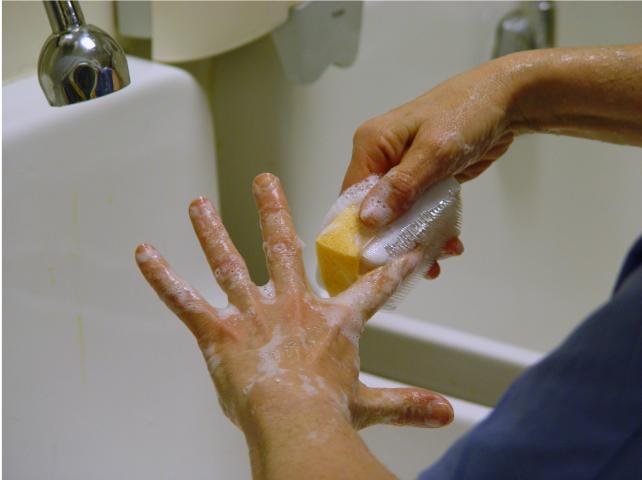Scrubbing Your Hands
Scrubbing your hands is much more than the routine hand washing we all do
before examining patients. It is a ritualistic procedure designed to
increase safety for the patient and for you.
Before
starting your scrub, make sure you are wearing a clean scrubsuit, surgical
cap and surgical mask. The cap should completely cover your hair. The mask
should fit securely, particularly over your nose, but not so tight that it
impairs your breathing. If you should cough or sneeze, the exhaled air
should be able to vent out the side of your mask. You will also need eye
protection against splash of body fluids. Some surgical masks include a
plastic screen. You may prefer to wear surgical goggles. Eyeglass wearers
sometimes rely on their eyeglasses to protect them. The degree of protection
depends on the size and fit of the corrective lenses.
Your hands have a lot of bacteria on them, particularly under the nails,
within the skin oils, and at the bottom of the skin folds. In theory, it
shouldn't matter how many bacteria are there since you will be wearing sterile
gloves during surgery. In real life, those gloves often develop holes in them
over the course of surgery.
The goal is not to eradicate every last bacterium from your skin (not
possible), but to drastically reduce the number of bacteria on your skin both at
the beginning of surgery and for its' duration. There are several very
satisfactory ways to do that:
-
 Traditional Scrub: Under running warm water, use a plastic nail file to
clean beneath the nails. Wet your hands and forearms up to the elbow. Once you
begin scrubbing, keep your hands above your elbows, so the water will drip
away from your hands and down to your elbows. Scrub brushes usually have two
sides (foam side and bristle side). Use the bristles for the palms of the
hands and underneath the nails. Use the foam side for everything else. Traditional Scrub: Under running warm water, use a plastic nail file to
clean beneath the nails. Wet your hands and forearms up to the elbow. Once you
begin scrubbing, keep your hands above your elbows, so the water will drip
away from your hands and down to your elbows. Scrub brushes usually have two
sides (foam side and bristle side). Use the bristles for the palms of the
hands and underneath the nails. Use the foam side for everything else.
Betadine scrub kills lots of bacteria and has long-lasting bactericidal
effects. It is an effective scrub solution, but some individuals develop skin
sensitivities to it. Other commercial scrub solutions can have similar
effects. Plain alcohol kills plenty of bacteria but can damage the skin and
has no lasting bactericidal effects once it has evaporated. Hand soap kills
many bacteria, is gentler on the skin, but lacks the long-lasting effects of
other preparations.
Scrub your hands and forearms, covering the entire skin area. Rinse and
repeat, up to several times. Total scrub time should be about 2 minutes. That
is long enough to do an effective job, but not so long as to damage the skin.
In the olden days, surgeons used to do a 10 minute scrub, but very few do this
anymore. The marginal decrease in bacteria counts is offset by skin damage and
long-term bacterial colonization of the traumatized skin.
-
Lotion scrub: Recent commercial scrub developments include a lotion (with
emolients, antibacterial chemicals, and alcohol) that are designed to be
rubbed into the skin of the hands and forearms. The lotion is rinsed off, and
a second application made. After final rinsing, the hands and forearms are as
bacteria-free as if a traditional scrub had been used. Advantages include less
trauma to the surgical team's skin, and faster preparation (you don't need a
full 2 minutes). Drawbacks include cost and contact sensitivity for the skin
of some of the team.
Once you have scrubbed, step back from the scrub sink and keep your hands
away from your body and at about chest level. Keep them raised like this while
you enter the OR (backwards through the door, using your hip to open it. This
stylized position offers the best protection against you inadvertently
contaminating your hands, and provides visual cues to those around you that your
hands are scrubbed and should not be touched. If you accidentally touch
something, just announce that you are contaminated, leave the OR and re-scrub.
|

